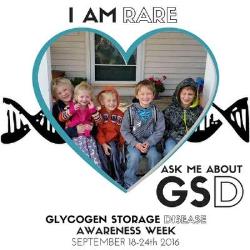It was even longer for the Final diagnosis of all 5 and the fact several seem to have two types and the severity level is abnormal and so the treatment that is barely one at most is even more of a struggle as they do not react as they think they should. This Disease is truly RARE and not understood and it will be many years even generations until a real treatment can be found but at this time I strive to keep my kids at as close to a normal life I can and keep them alive and as healthy as they can be. If you want to read from the start you have to go to the end of the journal and read backward. I did not start this until Kaitlyn was about 9 months old. So we had been in 9 months of hell with the threat of losing our Daughter daily and the abnormal sickness of our 4 boys.
It was a long battle leading up to the diagnosis of GSD Type 6 for Kaitlyn and Evan. We know God is with us and cares for our sweet children. This journey is life-long and will have many ups and downs. Thank you for following and praying with us.
What follows is a general description of GSD from the website
http://www.agsdus.org/index.html
.Glycogen is the storage form of glucose (sugar) in the body. It is a complex material made of individual glucose molecules linked together in long chains with many branches off the chains (just like a tree). Glycogen is mainly stored in the liver and muscle cells, but the kidneys and intestines also store some limited amounts of glycogen. Metabolism is the process by which our body breaks down the food we eat and converts it to energy. To briefly review metabolism: a simple form of sugar, called glucose, is our bodies’ main source of energy. After we eat, we have too much glucose in our blood, so our bodies store the extra glucose in the form of glycogen (much like we deposit our extra money in a bank). When our bodies need more energy, certain enzymes convert the glycogen back to glucose and withdraw it from the liver and the muscles (just like we withdraw spending money from the bank). The underlying problem in all of the Glycogen Storage Diseases is the use and storage of glycogen. All of the Glycogen Storage Diseases are considered inherited metabolic disorders. A metabolic disorder is a disease that disrupts metabolism. Therefore, a person who has a metabolic disorder has a difficult time breaking down certain foods and creating energy. A metabolic disease is most frequently caused by an absence or deficiency of an enzyme (or protein). An enzyme can act to help the body break down food into energy. There are many enzymes in the body and each act like a machine on an assembly line. When one of the enzymes is not working properly, the process of breaking down of specific foods can go more slowly or shut down completely.
A person with a glycogen storage disease (GSD) has an absence or deficiency of one of the enzymes responsible for making or breaking down glycogen in the body. This is called an enzyme deficiency. The enzyme deficiency causes either abnormal tissue concentrations of glycogen (too much or too little) or incorrectly or abnormally formed glycogen (shaped wrong). Depending on the type of GSD a person has, their enzyme deficiency may be important in all parts of the body, or only in some parts of the body, like the liver or muscle. Typically, the forms of GSD are described by the part of the body that has trouble because of the enzyme deficiency. The categories most often are the liver only, the muscles only, or both the liver and the muscles. Other systems that may be involved include blood cells (red blood cells, white blood cells, and platelets), heart, and kidneys amongst others.
All types of GSD cause the body to either not be able to make enough glucose, or not be able to use glucose as a form of energy. Determining what type of GSD a person has (diagnosis) depends on an individual's symptoms. Typically a doctor will do a physical examination and some blood and urine testing. Occasionally, a muscle and/or liver biopsy will be needed to measure the amount of a certain enzyme in that part of the body. There are about eleven known types of GSD, which are classified by a number, by the name of the defective enzyme, or by the name of the doctor who first described the condition.


